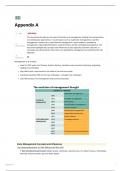Appendix A
Type self-study
This document provides an overview of the history of management, starting from ancient times
to contemporary approaches. It covers topics such as systematic management, scientific
management, bureaucracy, administrative management, human relations, quantitative
Description management, organizational behavior, systems theory, and the contingency perspective. The
document highlights key concepts and influences of each approach and their criticisms. It
concludes by mentioning the future focus on quantitative management and reinforcing the HR
approach.
Reviewed
Management is of all times:
back for 1000 years, the Chinese, Greeks, Romans, Venetians were involved in planning, organising,
leading and controlling
they didn’t have a real structure, but rather a trial-and-error base
Industrial revolution (18th C) and new challenges → brought new challenges
Late 19th Century, first management and business education
Early Management Concepts and Influences
The Industrial Revolution: (I) 1760-1840 and (II) 1870-1914
⇒ New manufacturing processes (Steam power, chemicals, machine tools, iron blast furnaces, mechanised
weaving), electrical power, gas and water supply
Appendix A 1
, ⇒ Communication and transportation (telegraph, railways)
Growth of business
Increased quality and quantity
From mills to factories:
from small-scale to mass production
Economies of scale → lower the costs of production
⇒ Intense and systematic thought about the problems and issues of efficiency, production processes and
cost-savings → the core of management thinking at the time
Classical Approaches
Mid 19th C through early 1940s:
Systematic management approach
19th C problems in manufacturing despite the advantages brought by the Industrial Revolution
coordination problems, chaos → breakdowns of production processes
response from the systematic management by:
building specific procedures and processes
emphasising efficient operations and processes, adequate staffing, management of inventories,
organisational control
Goals achieved:
definition of duties and responsibilites
standardised techniques for performing duties and responsibilities
means for gathering, transmitting, analysing information:
cost accounting, payroll administration, and production control systems to facilitate internal
coordination and communication
numbers are becoming a very important element
emphasis on internal operations, on things rather than people → to meet the explosive growth in
demand resulting from the Industrial Revolution
Scientific management (end of 19th C)
Weaknesses of the systematic management approach observed by Frederick Taylor:
Poor production and pay
Inefficiency and waste due to unused potential
Large differences in methods and the ways management decisions were made
No scientific approach in determining the best production mode
response:
Taylorism = answered the question “how to complete production tasks efficiently and increase
productivity?” through the application of scientific methods in analysing work, and in controlling
and managing production
Key: analysing of the task, and through thinking of the best approach to executing the task
Four key principles:
Appendix A 2




